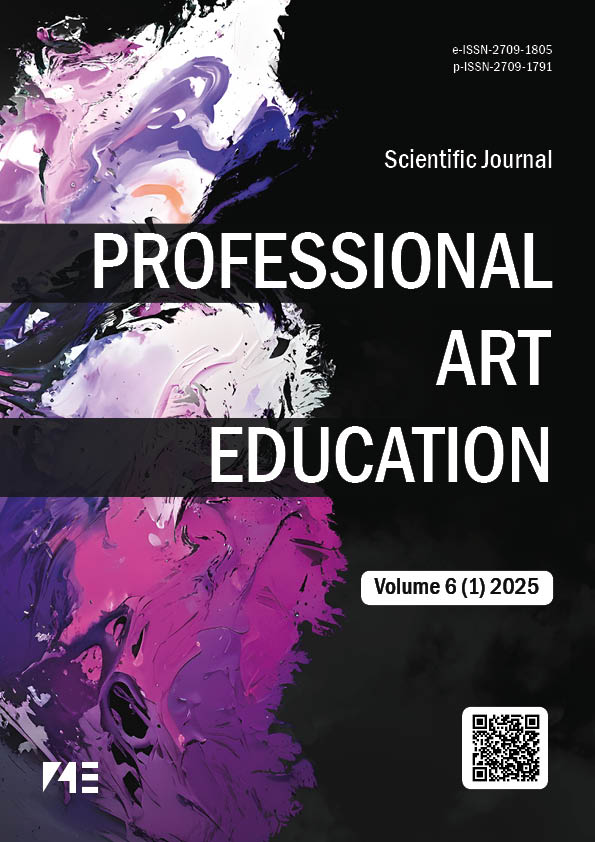Comparative study of visual arts curricula for secondary education institutions of Ukraine and Turkey
DOI:
https://doi.org/10.34142/27091805.2025.6.01.08Keywords:
Art education, secondary education, comparative pedagogy, UkraineAbstract
This article presents a comparative analysis of visual arts curricula in secondary education institutions in Ukraine and Turkey. The curricula of both countries are examined in terms of objectives, content, teaching-learning processes, and assessment systems. The study employs George Bereday’s four-stage model of comparative education alongside descriptive analysis. The findings reveal that Turkey’s curriculum emphasizes practical skills and the preservation of cultural heritage, while Ukraine’s program is based on theoretical foundations and aligns with a European-centered approach. Significant differences are also identified in the organization of instructional processes and assessment methods. The study highlights that art education is not limited to the development of technical skills but is a holistic system that fosters cultural identity and aesthetic sensitivity in individuals.
Object. The purpose of this study is to conduct a comparative analysis of the visual arts curricula in general secondary education institutions in Ukraine and Turkey. The study aims to identify the key goals, content structure, learning outcomes, and assessment strategies of both countries’ art education systems within their cultural, social, and political contexts.
Methods. The research is based on George Bereday’s four-stage model of comparative pedagogy and descriptive analysis. The content of the curricula is examined across components such as learning goals, competencies, educational processes, and evaluation methods (Bereday, 1964).
Results. The Ukrainian curriculum is characterized by a holistic, interdisciplinary, and value-oriented approach, emphasizing cultural identity, critical thinking, and personal expression through art. In contrast, the Turkish curriculum is structured, discipline-based, and focused on the transmission of technical skills and cultural heritage. While both countries’ programs highlight creativity and aesthetic sensitivity, their philosophical foundations and pedagogical priorities differ significantly. Ukraine favors emotional and ethical dimensions, whereas Turkey emphasizes measurable outcomes and artistic production.
Conclusions. The study reveals that both curricula reflect their respective educational philosophies and cultural priorities. Turkish art education aims to preserve national culture and develop practical skills, while Ukrainian art education promotes personal development, intercultural awareness, and social sensitivity. These findings may serve as a foundation for future educational reforms and policy development aimed at balancing creativity, technical competence, and cultural relevance.
Downloads
References
Aksoy, Ş., & Gürbüz, M. (2012). Türkiye ve İngiltere’de Ortaöğretim Görsel Sanatlar Öğretiminin Karşılaştırmalı Olarak İncelenmesi. Kurum ve Uygulamada Sosyal Bilimler Dergisi, 260-275. https://doi.org/10.48066/kusob.1200596.
Аліксійчук О. (2019). Методика Проведення Підсумкових Уроків Мистецтва в Основній Школі. Педагогічна освіта: теорія і практика, 10-15.
Bekiroğlu, A., & Tantan, A. (2022). İlkokul Görsel Sanatlar Öğretim Programlarının Karşılaştırlması: Yunanistan ve Türkiye Örneği. In The 14th İnternational Scientific Research Congress, (s. 193). https://doi.org/10.21764/maeuefd.1418473
Bereday, G. Z. F. (1964). Comparative Method in Education. Holt, Rinehart & Winston.
Buyurgan, S., & Buyurgan, U. (2019). Sanat Eğitimi ve Öğretimi (5. Basım). Ankara: Pegem A Yayınılık.
Feeney, S., & Moravcik, E. (1987). Aesthetic development in early childhood. Columbus: Merrill Publishing.
Gülyüz, S. (2021). Türkiye ve Güney Kore sanat eğitimi öğretim programlarının karşılaştırılması. Master's thesis, Necmettin Erbakan University.
Hurwitz, A., & Day, M. (1995). Children and their Art: Art Education for Elementary and Middle Schools. Harcourt Brace College Publishers.
Karameşe, E. (2016). Türkiye ve Kanada İlköğretim Görsel Sanatlar Dersi Öğretim Programlarının Karşılşatırılması Olarak İncelenmesi. Bartın Üniversitesi. Yüksek Lisans Tezi, 16-17.
MEB. (2018). Görsel sanatlar dersi öğretim programı (9, 10, 11, ve 12 sınıflar). Ankara: Millî Eğitim Bakanlığı
Паньок, Т., Канделакі, Т., Чиркіна, В., Бреславець, Д., & Глушич, Л. (2021). Вплив української школи мистецтвознавства на формування художньо-естетичних засад у контексті мистецької освіти хнпу імені Г.С. Сковороди. InterConf, (91). https://ojs.ukrlogos.in.ua/index.php/interconf/article/view/17062
Rogan , J., & Aldous, C. (2005). Relationships between the constructs of a theory of curriculum implementation. Journal of Research in Science Teaching, 313-336. https://doi.org/10.1002/tea.20054
San, İ. (1987). Sanat eğitiminin işlevi. Eğitim ve Bilim, 11(63), 15–22.
Stirker, S. (2005). Çocuklarda Sanat Eğitimi. (A. Akın, Çev.) İstanbul: Epilson Yayıncılık. https://surl.lu/sgknlj
Tatlı, S., & Adıgüzel, O. (2012). Türkiye'deki lisansüstü karşılaştırmalı eğitim tezlerinin çok boyutlu incelemesi. Anadolu Üniversitesi Sosyal Bilimler Dergisi, 143-150. https://kutuphane.dogus.edu.tr/mvt/pdf.php?pdf=0012083&lng=1
Tuna, S. (2020). Türkiye ve Bazı Avrupa Ülkelerindeki Ortaokul Görsel Sanatlar Ders Programlarının Karşılaştırmalı olarak Değerlendirilmesi. Ankara: Doktora Tezi, Ankara Üniversitesi.
Верховна Рада України (Законодавство України. Про повну загальну середню освіту (Відомості Верховної Ради (ВВР), 2020, № 31, ст.226) https://zakon.rada.gov.ua/laws/show/463-20#Text.
Міністерство освіти і науки України. Мистецтво (Рівень стандарту) 10-11класів. https://surl.li/cjrtlc
Yüksel, İ., & Sağlam, M. (2012). Eğitim program değerlendirme. Ankara: Pegem A Yayıncılık. https://akts.adu.edu.tr/programme-detail/4/7566/lecture/24113/
Yılmaz. (2011). Sanat Eğitimi ve Görsel Sanatlar Öğretimi. (A. Alakuş, & L. Mercin, Dü) Ankara: Pegem Yayınevi. 388
Данилов, В. В. (2023). Мистецька освіта Харківщини: становлення та розвиток. Програма VІI Міжнародної науково-практичної конференції для молодих науковців 25 травня 2023 року. Ніжинський державний університет імені Миколи Гоголя. https://salo.li/1834cb1
Downloads
Published
License
Copyright (c) 2025 Алі Ертугрул Кюпелі, Анварова Арзу (Автор)

This work is licensed under a Creative Commons Attribution-NonCommercial 4.0 International License.














